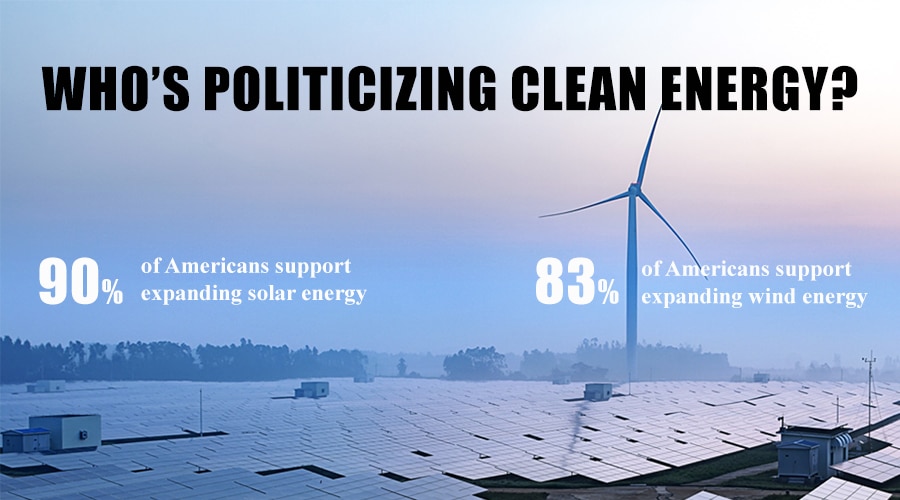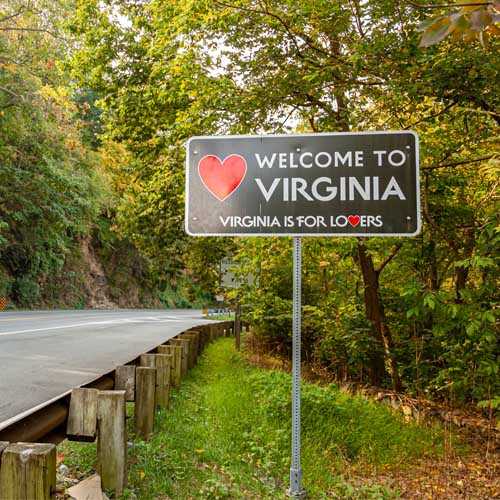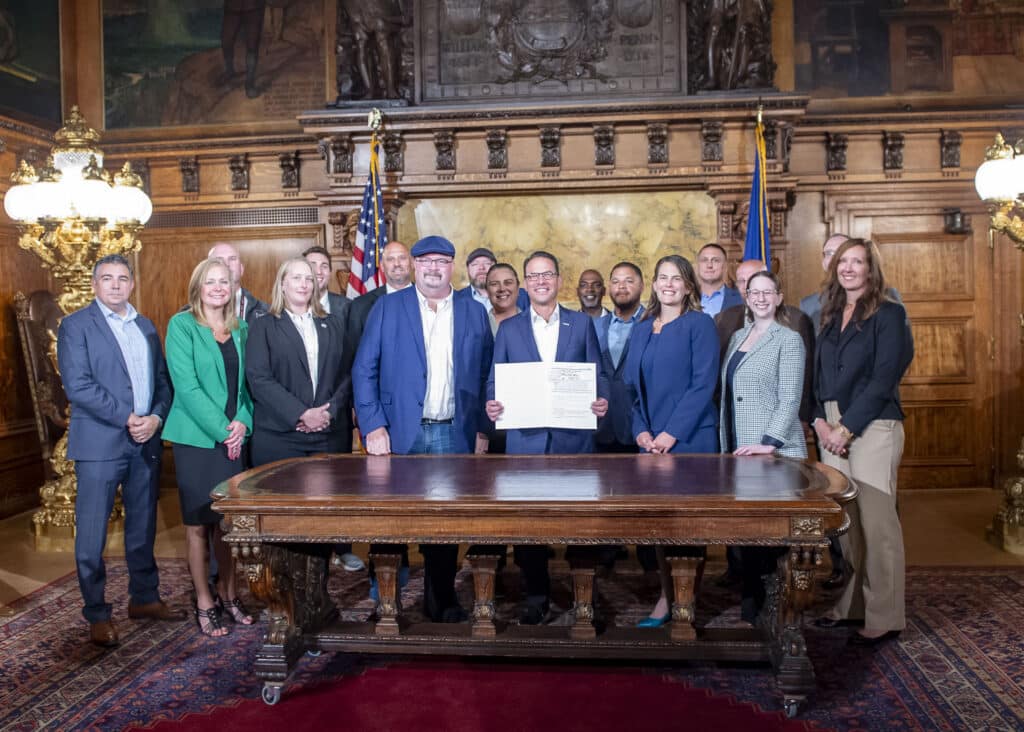This article is from the March 3, 2021, issue of Flip the Script, a weekly newsletter moving you from climate stress to clean energy action. Sign up here to get it in your inbox (and share the link with a friend).
Last month’s power system failure in Texas was a fiasco, and we can learn a lot from it about what not to do. One takeaway that should not go unnoticed: how politicized the energy climate in our country has become. People were freezing, many with no running water, and even before the facts were out, the disaster became all about politics. Well-known, mostly conservative, politicians and media personalities quickly (and falsely) placed the blame for the mass power outages on the state’s renewable energy supply—a mistruth that is only going to make it harder for us to get to the clean energy future we need.
So, why did this impromptu misinformation campaign happen? What’s the benefit of bashing renewables, which are not only widely popular (90% of Americans support more solar, 83% more wind), but are also helping make the U.S. more resilient, from both a climate and economic perspective? The answer is…well, politics. And money. Unfortunately, how we get our electricity, and from whom, isn’t just about identifying the cheapest and most abundant energy source and then flipping the switch. It’s a high-stakes game, and the fossil fuel industry isn’t ready to give up its (very large) piece of the pie. The Texas fiasco can be viewed as a perfect case study in how the fossil fuel disinformation machine perpetuates.
What actually happened in Texas?
Essentially, the Texas disaster was an unfortunate combination of a freakish weather event (which science suggests is made more likely by climate change) and a severe lack of preparedness on the part of the state’s power suppliers. A bitter cold snap hit the region, freezing up critical equipment at natural gas, coal, and nuclear plants (as well as non-winterized wind turbines) and knocking out generators at a time when natural gas supplies were already strained. At the same time, people began cranking up their heat, creating a surge in electricity demand that couldn’t be met with the available supply (in a scenario that far exceeded worst-case planning). With more than a third of the system’s generation capacity offline—almost all of it provided by crippled gas plants—the state grid operator had to declare a supply emergency. Utilities had to impose forced outages. The suffering that followed, including freezing indoor temperatures, deaths, and absurdly high power bills, is well-publicized by now.
The Texas fiasco can be viewed as a perfect case study in how the fossil fuel disinformation machine perpetuates.
The crisis affected the entire energy system. It was a systemwide failure that ended up slashing the capacity of both thermal (gas, coal and nuclear) and renewable power sources. The fiasco also reflected a failure of regulation, since much of the Texas power system is separate from the main U.S. grid, and oversight lies with the state legislature, which favors deregulation. Plant operators have been lax in weatherproofing their systems, and the state opted against paying suppliers to maintain reserve power capacity, relying instead on market forces to dictate electricity supply and distribution.
Lies and deflection
Despite these systemwide challenges, some took the crisis as an opportunity to zero in on clean energy. Even though wind power accounts for only around 10 percent of Texas’ power capacity during winter months, conservative politicians and commentators began falsely stating that the state’s expansion into wind was the key reason for the blackouts. In a Fox News interview, Texas Governor Greg Abbott stated that the shutdown of wind and solar generators “thrust Texas into a situation where it was lacking power”—even though he’d noted elsewhere that the impaired natural gas supplies were largely to blame. The lies were widely shared on social media, and a 2014 photo of iced-up wind turbines in Sweden was retweeted by thousands as “proof” of the severity of the Texas wind power freeze.
Proponents of the false claims also used the crisis as an opportunity to bash clean energy and climate efforts more widely. Personalities like Fox News host Tucker Carlson and House Republicans Dan Crenshaw (TX), Andy Barr (KY), and Lauren Boebert (CO) tweeted that pro-renewables legislation like the Green New Deal would “lead to situations like in Texas.” Conservative voices called the Texas power failures an example of Democratic mismanagement, and a Wall Street Journal editorial on the events observed that trying to eliminate natural gas and coal posed “a greater existential threat to Americans than climate change.” As the GOP disinformation campaign raged, MSNBC commentator Chris Hayes described it as a right-wing attempt “to turn Texas power outages into a culture war.”
Following the money
The common thread? Virtually all the “experts” commenting on Texas’ power situation on conservative media outlets, and the politicians parroting the lies about wind’s complicity in the blackouts, have links to the fossil fuel industry. Texas Senator John Cornyn, who shared the “renewables caused the blackout” story on social media, is a top Congressional recipient of oil and gas money, and Rep. Boebert and others have received extensive fossil fuel contributions. It’s a classic case of spreading disinformation for political and economic gain, and all you need to do is “follow the money.” The fossil fuel industry gets enormous subsidies, so in turn it exerts enormous financial influence to keep the status quo. All in all, this situation continues to politicize and poison the conversation around clean energy, making it much harder to get us where we need to be, even if the science is increasingly clear.
Virtually all the “experts” commenting on Texas’ power situation on conservative media outlets…have links to the fossil fuel industry.
Even after it became evident that wind capacity failures played only a very small part in the Texas power crisis, no politicians retracted their retweets of the false “frozen turbines” narrative. Ultimately, thermal energy systems were responsible for nearly twice as many outages as renewable sources, and many wind and solar plants in fact continued to produce energy during the freeze and in some cases exceeded expectations. “Wind was operating almost as well as expected,” said energy consultant Sam Newell, who noted that natural gas, coal and nuclear plants were down significantly more.
Wind is great for the state
The absurdity of all this, of course, is that wind power has been a huge boon to Texas. Over the whole year (not just during winter), the state gets around a quarter of its total energy supply from wind (and just over half from natural gas). Texas is the biggest wind power producer in the U.S. as well as a big player globally. Ironically the state became a wind rockstar after former governor (later U.S. president) George W. Bush—a Republican—signed a law in the 1980s deregulating the state’s power market, which opened it to new sources like solar and wind. Recognizing Texas’ abundant wind resources, the government invested $7 billion to build high power transmission lines to deliver clean, cheap wind power around the state.
Clean energy is also protecting Texas against climate change. Last July, Houston, a city hit hard by the recent blackouts, began purchasing 100 percent renewables for municipal operations, the first step in a city-wide goal to achieve carbon neutrality by 2050. Given that climate change will make weather events like this more frequent and more severe, Texas needs to be prepared to deal with future weather extremes. Key to future-proofing the grid and making the power supply more resilient is moving toward a more nimble, “smarter” grid fueled with growing shares of wind and solar. These efforts will also prepare the grid for future power demand as we begin to electrify everything on the path to net-zero emissions.
Getting real
However, this will all take much, much longer if the false narratives about clean energy continue to make the rounds. As Jamie Henn, the director of Fossil Free Media, stated recently: “We need to actually dismantle the industry’s disinformation machine…The failure of fossil fuels is what’s causing the blackout. We need to be out in front, putting the truth on offense. Reality is on our side: from now on, let’s make the fossil fuel industry respond to us, not the other way around.” We need to shift the narrative so that politicians acknowledge, not deny, the enormous opportunity that clean energy brings in making our country more livable and getting us through the climate crisis.















